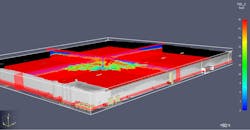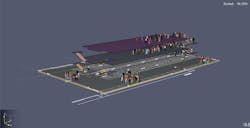How performance-based egress solutions help maintain the integrity of building designs
With recent trends in architecture and design, it has become increasingly difficult to remain code compliant when it comes to egress. Large atriums, open floor plans, and similar configurations, often require large and complex egress capabilities due to the prescriptive code and occupant load calculations.
Performance-based egress solutions can help circumvent these prescriptive requirements, while still keeping occupants safe in the event of an emergency, while also maintaining your desired building or space design. Understanding what a performance-based design is, how it can be applied to egress and life safety and understanding that it is crucial to get a fire protection engineer on board early are the three key components to getting a performance-based design approved by the authority having jurisdiction (AHJ).
Understanding Performance-Based Egress Design
Prescriptive codes refer to the adopted building codes in your jurisdiction–the IBC, NFPA 101, or similar. These codes define what the minimum requirements are for keeping occupants safe, and a way to meet these requirements—minimum travel distances to exits, lengths of dead-end corridors, common paths of travel, etc. However, if you were to utilize a performance-based design approach, you simply need to prove that your occupants meet this minimum level of safety, but in a way that’s not prescribed in the code.
It’s ultimately up to your local AHJ on whether or not they will approve this type of design, but NFPA 101 Chapter 5 outlines this option. It’s worth noting that there are a few items that can’t be changed from the prescriptive code even when utilizing a performance-based design. These include items like emergency lighting, minimum door widths, or stair tread heights. However, these are typically items that are standard in all new buildings, and often have less to do with the unique design you may be presenting than other variables like travel distance. The restrictions in NFPA 101 exist for two purposes: protect occupants not in direct contact with the initial fire, and improve the survivability of occupants who are in direct contact with the initial fire development.
Key Components of Performance-Based Egress Design
A performance-based design must achieve the same level of safety, in regard to the occupants, as the prescriptive code. Performance-based egress solutions boil down to the comparison of two key factors—the available safe egress time (ASET) and the required safe egress time (RSET).
Available Safe Egress Time (ASET): The amount of time it takes a fire to make an area untenable for human life.
Required Safe Egress Time (RSET): A calculation that defines how much time an occupant needs to egress an area of danger.
Calculating RSET
Three components affect RSET: alarm time, pre-movement time, and movement time.
Alarm Time
Alarm time refers to the amount of time it takes for an occupant to realize there is a fire. This involves analyzing the fire alarm and fire suppression systems and determining a safe estimate of time for an occupant to be alerted of the fire. Does the building have smoke detection? Sprinklers? How new or up to date is the fire alarm system? The answers to these questions can help determine this variable. This variable does not involve any human behavior, but is simply an analysis of the existing systems that are in place to alert the occupant of an emergency. In new buildings, the fire protection engineer could design a higher level fire alarm system than may be required in order to decrease this time. Reducing the RSET helps greatly in a performance-based egress design.
Pre-Movement Time
The next variable in question is the pre-movement time. This refers to the amount of time a person takes to decide to take action and begin exiting. This can vary depending on the occupancy of the building. Occupants may take time to determine if the fire is real, gather belongings, prepare to exit, etc., before deciding to start moving. For this variable it is important to think about the occupancy of your building—at a restaurant, someone can simply pick up their purse and begin moving. However, at a location like a hotel or office, an occupant could take time to gather important items before exiting.
Movement Time
The last variable related to RSET is movement time. This refers to exactly how much time it takes for an occupant to complete egress. Walking speed is the key factor, but other aspects may come into play depending on the occupancy of the building. For example, in a hospital or retirement home, movement time could be a lot slower than what is considered average because of people who may need assistance in egressing or who walk slower than the average adult. Additionally, the method of egress is involved here, as well. Is there simply an exit door that occupants need to pass through? Are there stairs involved? These variables would also impact movement time.
Computer programs such as Pathfinder assist in modeling egress scenarios to help determine a realistic RSET. These programs create building geometry and input variables regarding what could be expected of the building occupants—walking speed, reaction time, etc. These programs also factor in the expected and potentially unexpected behaviors that may occur. For example, it is unrealistic that exactly 50% of a room’s occupants will go to one exit, while 50% go to another. It is known that oftentimes an occupant will go to the exit door where they originally entered the room, even if another exit might be closer. These computer programs try to take various types of behaviors into consideration to create a realistic RSET.
The available safe egress time (ASET) is a bit harder to determine. This is the amount of time it takes a fire to make an area untenable for human life. This is typically done through computational fire modeling, taking into account what objects in the building could contribute to the fire, and the building construction or geometry. Aspects of these two items combined can determine ASET. For example, a pile of mattresses in a small room with a low ceiling would create untenable conditions much more quickly than a stack of heavy timber logs in a large room with a 20-foot ceiling. Fire protection engineers can build these simulations on a computer, however this process often takes time. It is important to ensure that engineers are brought on early to start this process, and ensure they cover all potential fire scenarios.
NFPA 101 Chapter 5 outlines what is required for the design fire scenarios, with eight specific scenarios which need to be modeled. These scenarios are intended to cover an array of variables—some specific to the occupancy or its contents, some related specifically to fire in the path of egress. Others that are required include fires that are in shielded spaces—inside a wall or in an area without fire protection systems. The goal is to cover all bases in the performance-based design, as these scenarios were partly used to generate the prescriptive requirements of the code. These are thought to be the eight ‘worst case’ scenarios, which is why they are used for life safety performance-based design.
At its most basic level, in order for a performance-based design to work, the RSET needs to be less than the ASET. The more data you have on your building, the occupants and the fuel, the more likely an AHJ is to accept the design. The goal is to have a thorough understanding of how your performance-based design keeps the occupants equally safe, or more safe, than the prescriptive code does.
Performance-Based Design Takes Time
Performance-based designs can take much longer than a prescriptive design, and often involve deeper conversations with the AHJ. It is essential to get the process started early, but even more important, to get a fire protection engineer on the project as early as possible. The last thing any stakeholder wants is to have to redesign, or cause project delays, due to egress issues that weren’t evaluated early on in the project. Life safety performance-based design is often a little more difficult to justify to the AHJ, given the direct risk of human life. Understandably, the last thing they want is to have an incident in their jurisdiction, however with a thorough examination of the performance-based design options and criteria, these solutions can help greatly in maintaining the integrity of your original architectural concept and design.
ABOUT THE AUTHOR
Alexa Kushner, MBA, Fire Protection Engineer at Telgian Engineering & Consulting, began her career in the Office of the Pentagon Fire Marshal where she evaluated complex egress routes, creating recommendations to maximize efficiency and assisted with the inspections of essential fire protection systems. Her experience includes a wide range of structures, from classified buildings with chemical storage facilities, to new-build commercial office space, to secure housing for inmates. Alexa’s expertise includes life safety calculations, as well as fire alarm and fire sprinkler design and calculations. Reach Alexa at [email protected].

